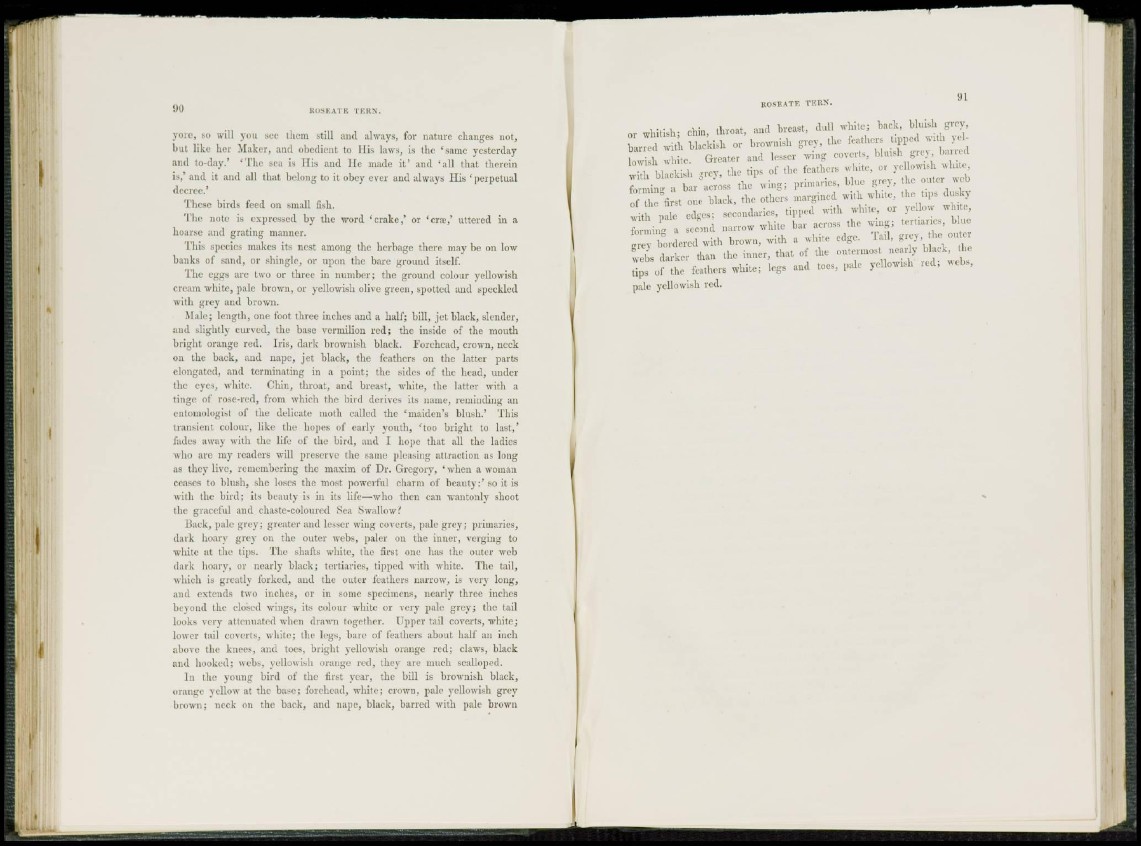
90 ROSEATE TERN.
yore, so will you sue lliem still and always, for nature changes not,
but like her Maker, and obedient to His laws, is the 'same yesterday
and to-day.' 'The sea is His and He made it' and 'all that therein
is,' and it and all that belong to it obey ever and always His 'perpetual
decree.'
These birds feed on small fish.
The note is expressed by the word ' c r a k e , ' or 'eras,' uttered in a
hoarse and grating manner.
This species makes its nest among the herbage there may be on low
banks of sand, or shingle, or upon the bare ground itself.
The eggs are two or three in number; the ground colour yellowish
cream white, pale brown, or yellowish olive green, spotted and speckled
with grey and brown.
Male; length, one foot three inches and a half; bill, jet black, slender,
and slightly curved, the base vermilion red; the inside of the mouth
bright orange red. Iris, dark brownish black. Forehead, crown, neck
on the back, and nape, jet black, the feathers on the latter parts
elongated, and terminating in a point; the sides of the head, under
the eyes, white. Chin, throat, and breast, white, the latter with a
tinge of rose-red, from which the bird derives its name, reminding an
entomologist of the delicate moth called the 'maiden's blush.' This
transient colour, like the hopes of early youth, 'too bright to last,'
1'ades away with the life of the bird, and I hope that all the ladies
who are my readers will preserve the same pleasing attraction as long
as they live, remembering the maxim of Dr. Gregory, 'when a woman
ceases to blush, she loses the most powerful charm of b e a u t y : ' s o it is
with the bird; its beauty is in its life—who then can wantonly shoot
the graceful and chaste-coloured Sea Swallow.'1
Back, pale grey; greater and lesser wing coverts, pale grey; primaries,
dark hoary grey on the outer webs, paler on the inner, verging to
white at the tips. The shafts white, the first one has the outer web
dark hoary, or nearly black; tertiaries, tipped with white. The tail,
which is greatly forked, and the outer feathers narrow, is very long,
and extends two inches, or in some specimens, nearly three inches
beyond the closed wings, its colour white or very pale grey; the tail
looks very attenuated when drawn together. Upper tail coverts, white;
lower tail coverts, white; the legs, bare of feathers about half an inch
above the knees, and toes, bright yellowish orange red; claws, black
and hooked; webs, yellowish orange red, they are much scalloped.
I n the young bird of the first year, the bill is brownish black,
orange yellow at the base; forehead, white; crown, pale yellowish grey
brown; neck on the back, and nape, black, barred with pale brown
ROSEATE TERN.
or whitish; chin, throat, and breast, dull white; back, bluish grey,
barred with blackish or brownish grey, the feathers tipped with yellowish
white. Greater and lesser wing coverts, bluish grey, barred
with blackish grey, the tips of the feathers white, or yellowish while,
forming a bar across the wing; primaries, blue grey, the outer web
of the first one black, the others margined with white, the tips dusky
with pale edges; secondaries, tipped with white, or yellow white,
forming a second narrow white bar across the wing; tertiaries, blue
grey bordered with brown, with a white edge. Tail, grey, the outer
webs darker than the inner, that of the outermost nearly black, the
tips of the feathers white; legs and toes, pale yellowish red; webs,
pale yellowish red.